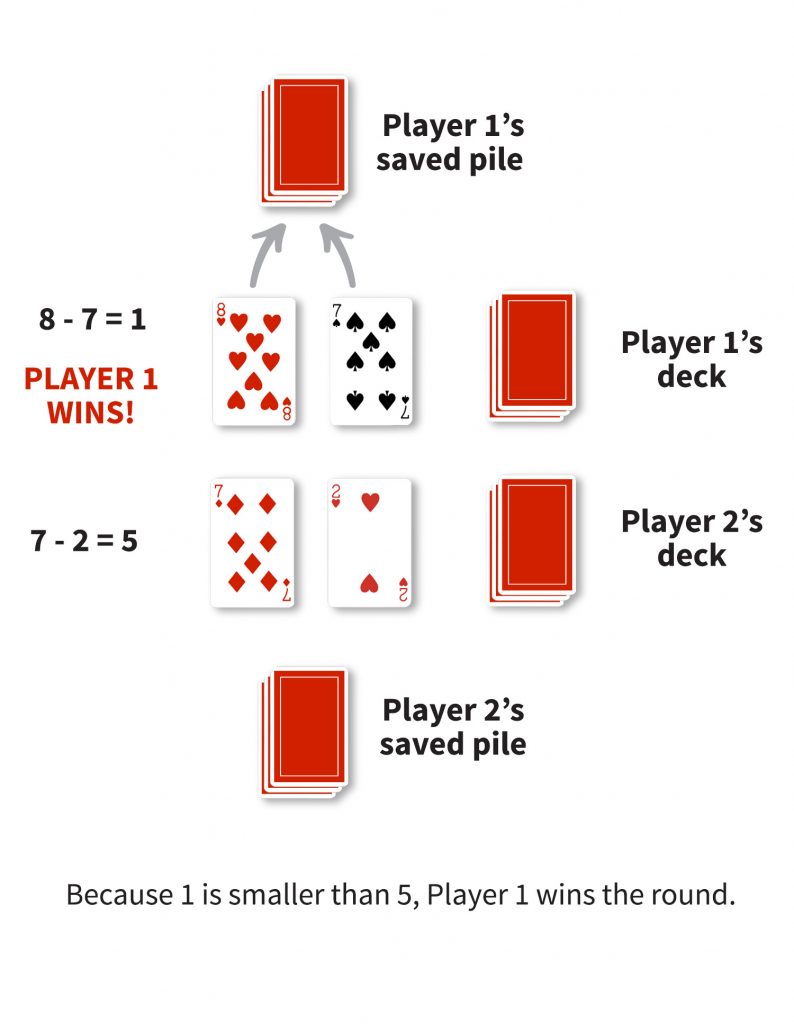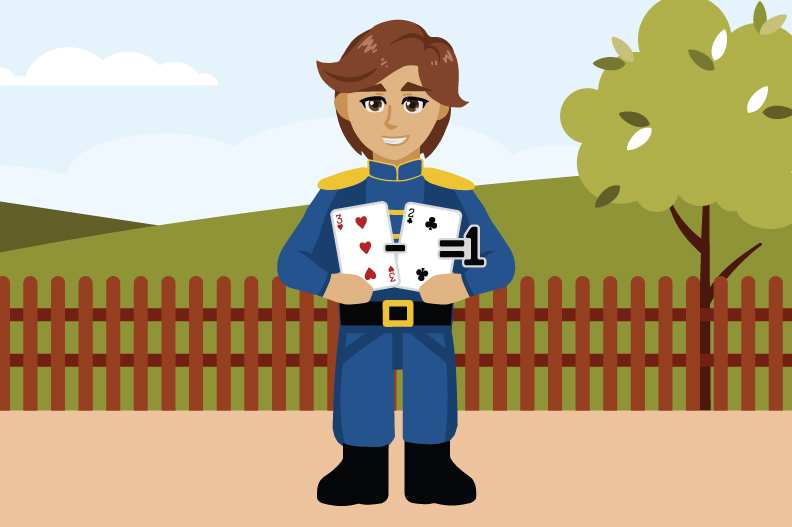Activity Summary
In this 2-4 player game, draw two cards and subtract the lower card from the higher one. Whoever has the smallest answer wins the round. The player who wins the most rounds wins the game.
Instructions
Setup
- Take out all face cards. Aces count as 1.
- Be sure to shuffle the cards.
- Pass out all the cards in the deck so each player has an equal number.
- Players take two cards from their pile and put them in a row, number side up.
Play
How a turn begins:
Each player subtracts their lower number from their higher number. For example, if a player has a 7 and a 2, they could say, “If I start with 7 and take away 2, I have 5 left. So, 7 – 2 = 5.”

How a turn ends:
The player with the smallest difference between the two numbers wins all four cards and puts these cards in their own pile of saved cards. A difference is the amount left after subtracting a lower number from a higher number. For example, 8 – 7 = 1, and 7 – 2 = 5; 1 is smaller than 5, so the player who gets 1 wins all four cards. If both players have the same difference, they play another round, with two more cards for each player. The person who wins that turn gets all the cards.
How the Game Ends:
Play continues until the players have no cards left. The winner is the one with the most cards in their own saved pile.
Tips
Read the Mini Story
- Make playing even more fun by telling a story about the game: Count Jack is tricky! Sometimes when he plays card games, he likes to take numbers away. Can you figure out what numbers he’ll get when he takes a small number away from a big number?
Support Learning
- Suggest using fingers. Put up as many fingers as match the higher number. Then put down the number of fingers to match the lower number. For example, if your child has a 7 and a 2, put up 7 fingers, then put down 2 of them. Count the 5 fingers still held up.
- Use things you have at home. Get a small pile of pennies, spoons, or other small items. Show your child how to start with one number, and then take away some items.
- Count back. Start counting with the higher number and count backward. For example, if your child has a 7 and a 2, say “7, 6, 5. See, you counted backward two times to get to the 5.” Children can use their fingers or the shapes on the cards to keep track of how many times they have counted back.
- Solve an easier problem. If your child is trying to figure out 7 minus 2, try 7 minus 1 first.
- Make up a visual story to go with the numbers. For example, if you have a 7 and a 5, you could say, “I have 7 cookies and I ate 2 of them. How many do I have left?”
- If your child turns over two of the same number, help them see that the difference between the two numbers is zero.
Adjust the Challenge
Make It Easier
- Remove cards from 6 to 10 from the deck. Play the game only with numbers 1 to 5.
Mix Things Up
- The player with the largest difference wins.
- Ask your child to estimate who will be the winner of each round before doing the subtraction. Ask how they figured it out.
- Find out if your child can see the relationship between addition and subtraction. For example, if your child knows 5 + 2 = 7, can they use that to figure out 7 – 2 = 5?
Make It Harder
- Leave all the face cards in the deck. Each face card can count as 10.
- Have players use three cards from their pile. Players should add the two highest cards and subtract the lowest card.
What to Play Next
If your child is still practicing the skills in this game, then continue having fun playing this game! Try the tips to support learning and ways to adjust the challenge. When your child is ready for a new game, play What’s the Secret Number?
Download this activity
English version
Download Game 8